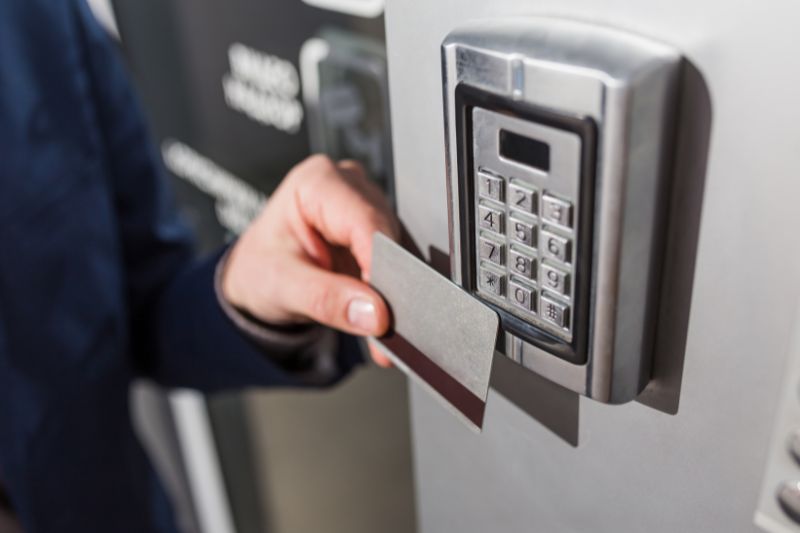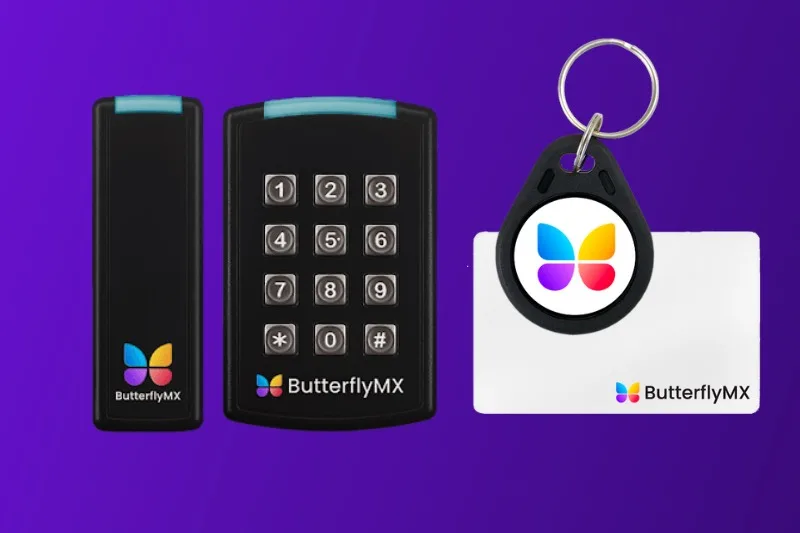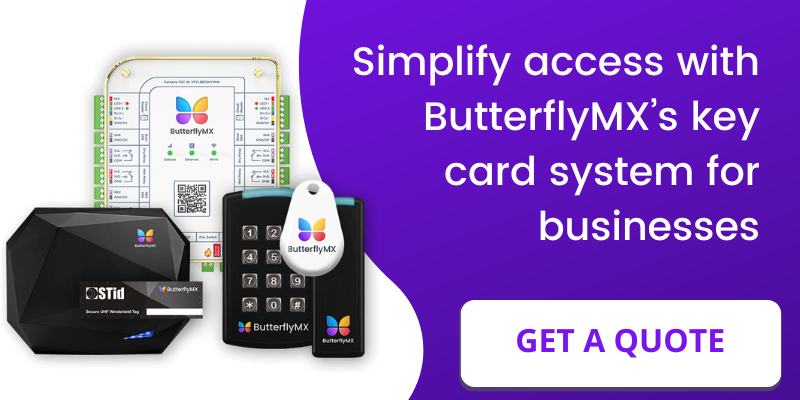Key takeaways
- Proxy cards, magnetic stripe cards, and smart cards are the main types of key card entry systems.
- Key card door entry systems offer quick access and are easier to manage than traditional keys, but they fall into the same pitfalls as physical credentials, such as being stolen.
- Consider the customization capabilities, user experience, and supported credentials when choosing a key card access control system.
- Mobile access and keypad entry systems are the best alternatives to key card security systems for businesses.

Key card and key fob systems for commercial properties are popular because they offer advantages over traditional locks and keys. More specifically, key card security systems for businesses are the best way to manage access to your property.
Therefore, this post outlines the best key card security systems. In addition, you’ll discover the types of key card entry systems, their pros and cons, and how much they’ll cost. Lastly, we cover what to consider when purchasing a system and potential alternatives you could pursue.
This guide covers:
- 3 best key card security systems for businesses
- Types of key card door entry systems
- Pros and cons of key card systems for offices
- Considerations for key card security systems
- Alternatives to key card access control systems
- Key card security system FAQs
3 best key card security systems for businesses
There are numerous key card security systems for businesses, but we’ve selected the three best below.
The three best key card security systems for businesses are:
1. ButterflyMX
ButterflyMX is a cloud-based access control company installed in over 10,000 buildings and garnered more than 20,000 five-star reviews. Since 2014, ButterflyMX has made access simple by enabling users to enter with the credentials of their choice, whether through our highly-rated mobile app or encrypted key cards and fobs.
Features of ButterflyMX
- Keypads and readers. Choose from three readers that match the aesthetic of your property and the credentials you want: keypad, mullion, and single-gang. For your convenience, the readers accept key cards, fobs, the ButterflyMX mobile app, and PIN codes.
- Audit trails. Review your property’s entry events in a single dashboard, simplifying security efforts. Every entry event includes detailed information about the credentials used, the person they’re assigned to, the time and date, and more. In turn, you can better respond to potential security breaches or identify suspicious activity, increasing the safety of employees and customers.
- Remote management. Manage every aspect of your key card security system remotely. Through the ButterflyMX mobile app or online dashboard, you can review audit logs, manage permissions, and even grant access remotely. Therefore, you don’t have to be on-site to manage any of your properties’ security, saving you time and money.
- Weatherproofing. Our IP55 outdoor-rated system ensures your key card and fob access control can withstand the elements. Our keypads and readers won’t let in water, dust, or chemicals, which means they’ll last for many years and continue to work in all types of weather.
- Integrations. ButterflyMX supports a wide range of third-party integrations, allowing you to manage your business from a single platform. You can integrate your key card security system with property management software, video surveillance, elevators, smart locks, and more.
- ButterflyMX platform. Use your access control system alongside ButterflyMX’s other products, such as elevator controls, front desk stations, video intercoms, and vehicle access control. This way, you can manage access throughout your entire property, increasing security without sacrificing convenience.
2. HID
HID is a global leader in access control technology, making it a great solution for businesses to use for key card security systems. You’ll also have the choice of biometric access control, mobile access, touchless RFID technologies, and more options.
HID also supports mobile credentials through its mobile app and allows your business to manage access the way you want, from standard readers to more complex solutions. Regardless, HID’s system is cloud-based, allowing you to receive new features and updates after installation.
Overall, HID can offer your business the following:
- Mobile access
- Touchless access control
- Smart buildings
- Key card and fob readers
- Biometric readers
- Keypads
- Door controllers
- Key cards, fobs, tags, and other physical credentials
3. Linear
Established in 1961, Linear has built a reputation as a trusted brand in the access control industry. Its standout feature is its wide range of options tailored to diverse organizations. For instance, businesses can opt for PC-based or browser-based access control systems. Linear is suitable for all types of buildings, such as medical facilities, campuses, schools, places of worship, and more.
Linear offers the following products for your access control needs:
- Telephone entry systems
- Keypads
- Single door access
- Readers
- Credentials
- Transmitters and receivers
Learn how the ButterflyMX access control platform works:
Types of key card door entry systems
When it comes to key card door entry systems, the credentials are typically what differ. That said, only a few types of key cards may be used, which will determine how your system looks and functions.
The main types of key card door entry systems are:
Proximity cards
Also known as “prox cards,” proximity cards are the most common type of card used. They operate using radio frequency identification (RFID) and contain a small RFID tag that holds the data necessary to grant access.
When the card is within proximity of a reader, the data from the tag is sent through low-frequency radio waves to the reader for authorization. The card does not have to come in contact with the reader, hence the name.
Magnetic stripe cards
These cards may also be called “swipe cards” because you must swipe them through a reader to gain access. This cheaper alternative to RFID cards features a magnetic stripe on one side of the card. To enter an area with this card, a user must physically swipe the card through the reader before entering.
As such, magnetic stripe card systems are less prevalent than proximity card systems. In most cases, you’ll find magnetic stripe card systems in areas where security isn’t necessarily the focus, such as gaining access to a printer.
Smart cards
Similar to proximity cards, smart cards are a type of contactless credential that uses a high frequency to transmit data. They contain a microchip capable of storing more data than the traditional RFID card. While smart cards are mostly used as payment cards, facilities requiring robust security solutions may use them for access credentials.
Pros and cons of key card systems for offices
Key card security systems for businesses and offices are chosen by many because of the advantages they offer. However, you must also know of potential drawbacks they may have.
What are the advantages of key cards?
- Convenience. Key cards eliminate the need to carry multiple keys on a ring. Not to mention, you won’t have to store so many keys, which can get tedious. Rather, a single key card can grant you and other users access to all authorized areas.
- Quick access. Traditional keys slow the process of entering a property, but key cards make it quick and simple by only requiring a quick swipe of a card near the reader.
- Easier management. Manage access to your property more easily with key cards. These credentials can be deactivated at any time, so when a user loses it, your property won’t be accessible to strangers who might have found or stolen the card. Plus, simply assigning a role to the card and user gives them access to defined areas, preventing the need to make multiple keys.
What are the disadvantages of key cards?
- Initial cost. The upfront costs of installing a key card security system for a business can be significant. However, the cost savings you receive over time will be more than enough to make it worthwhile, especially when you choose a cloud-based system.
- Physical credential. Key cards are still physical credentials, which can be lost or stolen. Thus, someone could easily use the card before the user knows it’s gone, creating a potential security risk. Standard key cards and fobs can also be copied or skimmed from a distance, allowing anyone to enter your property. Choose a system that uses encrypted key cards, like ButterflyMX, to prevent unauthorized copying.
- Replacement costs. Replacing physical key cards costs money. While the cost of a single key card isn’t a lot, replacing lost or stolen cards regularly will add up. That said, key cards can be reused, unlike traditional keys, making them more suitable credentials.
Considerations for key card security systems
Before you move forward with a key card security system, you should know what to look for when selecting a platform. After all, you want a system that can meet your business’s security and operation demands.
We recommend you consider the following when choosing a key card security system:
- Supported credentials. A robust system should not only rely on key cards but also support various types of credentials. This flexibility allows users to seamlessly switch to alternative access methods, such as PIN codes or a mobile app, in case of lost cards. In turn, users can continue on their way.
- User experience. The system’s user experience is crucial for smooth business operations. Opt for a user-friendly and intuitive interface that requires minimal training to manage. This ensures that employees can navigate the system effortlessly, reducing interruptions to daily tasks.
- Integrations. Look for a system that integrates seamlessly with other technologies used in your business. Centralizing property systems on a single platform enhances both security and operational efficiency. This unified approach streamlines management and improves overall effectiveness.
- Reliability and durability. Prioritize systems that are built to withstand various environmental factors and wear and tear. Ensure the system can endure dust, water, and extreme temperatures to maintain reliability over time.
- Customization. Choose a flexible and scalable system to adapt to your business’s evolving needs. Customization options allow you to tailor the access control system to your specific requirements, ensuring it can grow alongside your business and encompass any types of roles you need to avoid disruptions.

Alternatives to key card access control systems
The best alternatives to key card access control systems are keypad entry and mobile access control.
Keypad entry systems offer a straightforward and cost-effective security system solution. Users input a numeric PIN code to gain access, eliminating the drawbacks of physical credentials. These systems offer the same convenience and security as key card access control but lower costs by not having to replace cards or fobs.
On the other hand, mobile access control leverages credentials that everyone already has in their pocket: smartphones. Users download a mobile app, which grants them access when authorized in the cloud. As a result, you don’t have to purchase physical credentials for users, and you can remotely manage your system via the mobile app or online dashboard, enhancing convenience and security.
Key card security system FAQs
- How much does a key card entry system cost for businesses?
- Is a key card the same as a debit card?
- Are key cards safer than keys?
How much does a key card entry system cost for businesses?
On average, a key card entry system for businesses costs $1,000 to $3,000 per door. However, costs will vary depending on your chosen system, manufacturer, features, and more. The cost estimate does not include installation, maintenance, key cards, or subscription fees.
Is a key card the same as a debit card?
No. Key cards are not the same as debit cards.
Key cards are strictly used as credentials to enter specific areas of a property, while debit cards are used to make purchases.
Are key cards safer than keys?
Yes, key cards are safer than keys because they can be remotely deactivated even if they are stolen. That way, the thief cannot access the property with the stolen credentials. Key cards can also be encrypted, preventing them from being cloned, whereas a metal key can be copied with the right tools.







